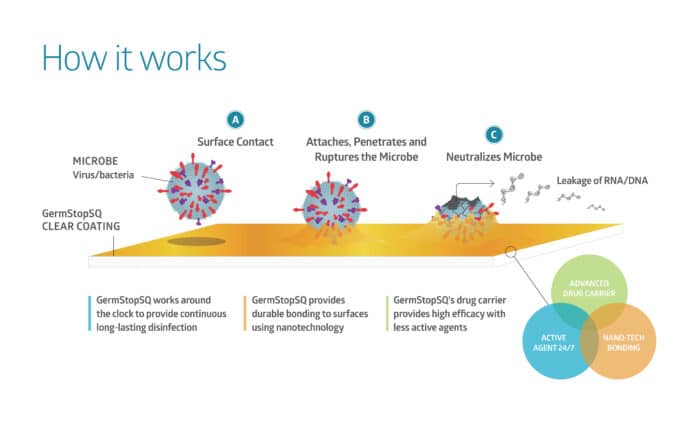Controlling the spread of infection is a critical issue for hospitals and long-term care facilities. Point-prevalence surveys by the Canadian Nosocomial Infection Surveillance Program found 7.9% of patients in acute-care hospitals had at least one healthcare-associated infection (HAI). Meanwhile the Public Health Agency of Canada reports that HAIs kill thousands of people each year.
But disinfecting surfaces isn’t easy, because it requires enough contact time to kill any microorganisms present. A 2011 study found that even after four rounds of bleach disinfection, 14% of hospital rooms still contained methicillin-resistant Staphylococcus aureus (MRSA).
And even with rigorous disinfection regimens, a single touch or sneeze from an infectious person can re-contaminate the surface.
Residual disinfectants offer a radically more effective way to kill germs, providing sustained disinfection long after they’ve been applied.
First residual disinfectant approved by Health Canada
GermStopSQ is the first residual disinfectant to be granted a Health Canada drug identification number, based on EPA testing protocols. Applied as a liquid, it starts killing germs on contact. Once it dries, it forms a thin invisible coating that continues to kill bacteria and Coronavirus 229E.
“This really is a game-changer that cuts infection rates and saves labour,” says Scott Shayko, CEO of Toronto-based GermStopSQ Inc. “A single application of GermStopSQ provides 24 hours of continuous hospital-grade disinfection.”
To date, GermStopSQ is the only residual disinfectant to meet the EPA’s rigorous requirements. This entailed testing the product’s effectiveness against Staphylococcus aureus, Pseudomonas aeruginosa and Coronavirus 229E, a proxy for the COVID-19 virus.
In each case, disinfected samples were subjected to cycles of abrasions (alternating between wet and dry) and re-inoculations with the microorganism in question, mimicking repeated contamination and wear on high-touch surfaces.
“After 12 cycles of abrasion and inoculation, our product continued to kill more than 99.999% of bacteria, as well as more than 99.9% of Coronavirus 229E,” says Dr. Cheng Lu, chief scientist of GermStopSQ Inc.
Combining high efficacy with low toxicity
Lu adds that GermStopSQ kills higher levels of bacteria and viruses with much lower volumes of quaternary ammonium compounds than currently available sanitizers and disinfectants, thanks to the company’s advanced drug-carrier technology.
As a result of that safety profile and efficacy, Health Canada has approved GermStopSQ for all use areas, including hospitals and long-term care facilities. “This is an ideal solution for high-traffic, high-touch areas like waiting rooms, elevators and hallways,” says Shayko.
GermStopSQ was developed with funding from several advanced-research programs and government agencies, including the Department of National Defence. Recently, it was singled out as an innovative product for 2025 at the Infection Prevention and Control Canada (IPAC Canada) national conference.
GermStopSQ is currently available in sizes up to 1,000L at www.germstopsq.ca.

